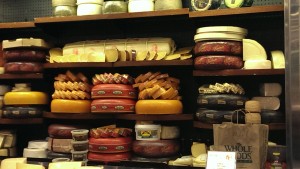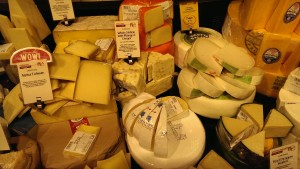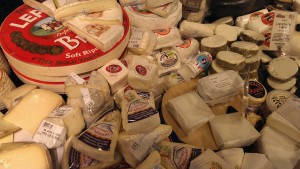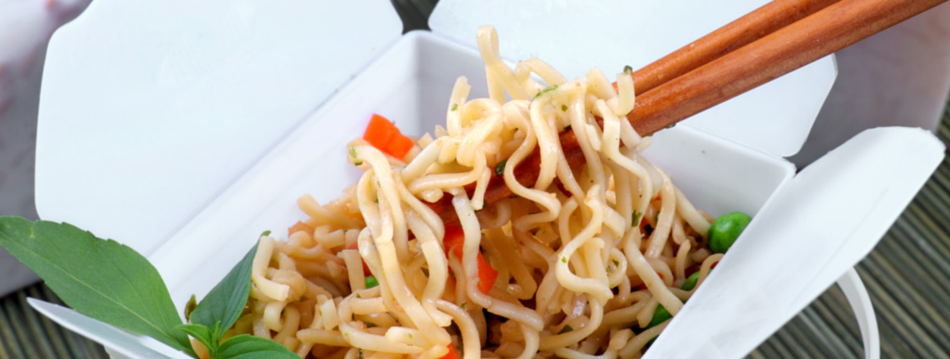
On Saturday I posed a question on my Facebook page: “What is your favorite cheese?” To my surprise, I was inundated with replies, not surprisingly there were many more nominees than there were nominators. I too have a hard time choosing just one, and as I read each reply, found myself saying “Oh, yes, I forgot that one, I love it too.” Whether you are a cheese eater or not, cheese is a wondrous thing, if only looked at from a scientific perspective. There are something like eighteen trillion types of cheese (I could be exaggerating here) and all of them, all of them start out with just one ingredient—milk. It may be cow, sheep, goat or a mix, but every single cheese, from the bland, buttery Fromager D’affinois to the most pungent Limburger started out as milk.

Selection of Goat Cheeses
My friend Pat used to raise goats, and we tried our hands at making goat cheese, when she found herself with a surplus of goat’s milk… We were not successful, and it’s too bad I didn’t know about Cajeta then, because it takes a whole lot of goat’s milk to make that, and I think that would have ended better. But back to cheese. I have read that cheese making started accidentally (like fig Newtons and Silly Putty) when Nomads carried milk in pouches made from the stomachs of animals, and that milk, sloshing around with all those enzymes left in the lining, and a lack of refrigeration created the perfect environment to create something cheesy.
People have been making cheese for as long as they have been domesticating animals like sheep and goats, which is somewhere between eight and ten thousand years. Initially cheese making was limited to Europe and the Middle East until Europeans began traveling and settling in the Americas. While not a typical Asian food, at least one type of cheese called “rushan” has been produced in China since the time of the Ming Dynasty and continues to be a staple in the diets of the Sani and Bai people. The Tibetans and Mongolians also have a long history of producing cheese and may have had an influence in Chinese cheese making. Parmigaino Reggiano, the king of cheeses dates back only a short five hundred years!

The Softees! My favorites.
Making cheese, and more specifically making a particular type of cheese is where things get interesting. I will give you a very abbreviated version, but you can look here for more in depth description. All cheese gets started by inoculating it with lactic acid bacteria and rennet, which causes curds to form, and then the curds (the solids) are separated from the whey, the liquids (mainly water). The whey is generally discarded, and the curds are put into cheese presses to slowly remove any remaining whey, and then go through the ripening process based on the particular type of cheese. Blue cheeses are injected with mold, and you can often see the ‘tracks’ from the needles used to insert the bacteria.
Cheeses are all about character. There are the hard cheeses like Parmigiano and aged Goudas, which have deep, nutty flavor, and one of my favorite characteristics of these cheeses is the crunchy, crystallized stuff I thought was salt that forms as they age, but isn’t. If you see white specks in one of these cheeses, it’s not mold, it’s salt. Rinds come in all sorts of varieties, and generally are edible, though when you see the obligatory brie at a party invariably the inside has been scooped out of the rind, which is actually part of the cheese itself, and forms as the cheese ages and ripens. There are all kinds of rinds; washed, soaked in wine, coated with ash—usually the ash of grape or other type of vine, and there are cheeses with coverings, like the red wax found on young Goudas. Coverings are not edible. Some of my favorite cheeses are those where the aging is apparent. there is a definite rind, and the cheese goes from a chalky outer to an almost runny inside layer, this is typical of a Bucheron or one of my favorites Humboldt Fog.
Every great cheese has a story, but I particularly love this one. Humboldt Fog is a California cheese from the wonderful Cypress Grove , and an homage to the famous French Morbier. The bottom layer of made from the evening milk, covered with a layer of ash, then topped with a layer of curd made with the morning milk. I’m not sure why I find this story so engaging, but it evokes images right out of a Jean Françoise Millet painting.

Jean-Francoise Millet 1859
There are more cheeses than I can enumerate, but here is a good source (which lists the number of cheeses at 700, not the eighteen trillion I suggested) to find your favorites and to look for new ones to try. My favorites are included in the list below, and I’d love to hear from you so I can add to this list.
WHAT IS YOUR FAVORITE CHEESE?
Here is the list of favorites from the people who participated in my completely unscientific poll in no order at all!:
Feta in oil, Manchego, Humboldt Fog, Sottcenere, Ossau Iraty, Fromager D’Affinois, Aged Gouda, Parmigiano Reggiano, Cana d’Cabra, Prima Donna Gouda, Jasper Hill Cloth Bound Cheddar, Green Peppercorn Cana d’Cabra, Halloumi, Maytag Blue, Rogue River Blue, Roqufort (wrapped in black paper), Cool’ea, Gorgonzola Dolce, Mousseron Jurassien, Taleggio, Hooks Cheddar (10 or 15 yr), Delice de Bourgogne, Castello, Epoisse, Cowgirl Creamery Mt Tam, Le Tur, Vacherin Mont d’Or, Tommes des Alpes, Pont L’Eveque Crotin de Chavignol, Tomme de Savoie, Robiola, Capricio de Cabra, Stilton, Brilliat Savarin, Montagnolo, Cave aged Emmenthaler, Compte, French Muenster, and lat (for now) Piave.




.jpg)




